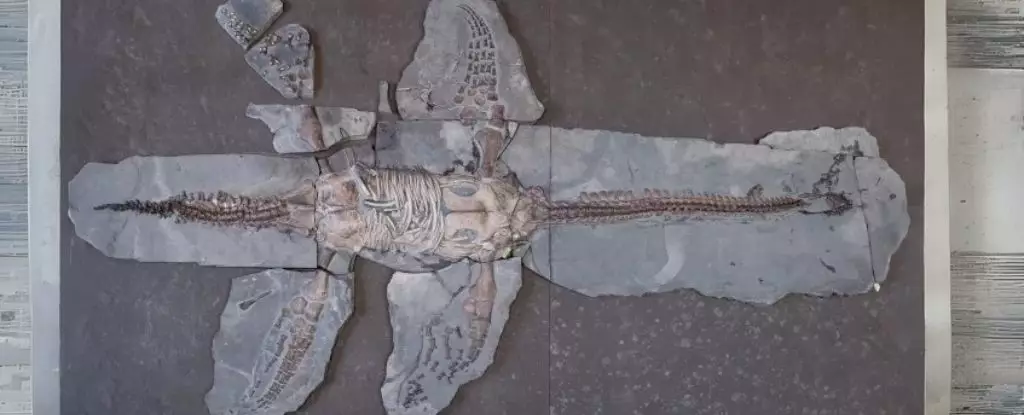The intricate tapestry of prehistoric life continues to captivate scientists and enthusiasts alike, particularly when it comes to iconic marine reptiles like the plesiosaurs. These unique creatures, characterized by their distinctively long necks and robust, four-flippered bodies, dominated the oceans during the Mesozoic era. Recent studies into well-preserved fossils have begun shedding light on their adaptations, behaviors, and physiological traits that contributed to their evolutionary success.
The Significance of Recent Discoveries
A fascinating fossil, dating back 183 million years to the Jurassic period, has surfaced in recent research led by a team from Lund University. This particular specimen, identified as MH 7, is remarkable not only for its age but also for the level of detail it provides about plesiosaur biology. Excavated in Germany’s Holzmaden after a tumultuous history during World War II, this fossil brings forth substantial insights into the anatomical features of plesiosaurs, particularly concerning their skin and flippers—features that underscore their adaptation to marine life.
The study utilizes advanced techniques like microscopy and spectroscopy to grant unprecedented access to the soft tissue characteristics of a plesiosaur, a rare achievement given that only a handful of such samples have been retrieved from fossilized remains globally. Such techniques unveil minute details, helping researchers understand how these giants operated in their aquatic environments. The findings highlight the evolutionary paths that these reptiles took in response to their surroundings, as well as how they might have interacted with contemporaneous marine organisms.
One of the pivotal revelations from the study is the presence of flipper scales reminiscent of those found in present-day sea turtles. The existence of these scales may suggest that plesiosaurs, much like modern aquatic reptiles, evolved specialized features to enhance their locomotion in water or provide support while traversing marine substrates. The team postulates that these scales may have served dual roles: facilitating efficient swimming through hydrodynamic design and improving traction on the ocean floor where they likely searched for food.
This aspect of the plesiosaur’s adaptation is particularly noteworthy; the presence of scales indicates a complex evolutionary trajectory that enabled the species to thrive in various ecological niches. The accompanying hypothesis suggests that both plesiosaurs and modern turtles faced similar hydrodynamic challenges, resulting in analogous adaptations, a phenomenon known as convergent evolution. This reinforces the idea that despite their extinction millions of years ago, plesiosaurs shared fundamental survival strategies with modern marine reptiles.
The reproductive traits of plesiosaurs also present a compelling narrative about their biology. Evidence indicates that, akin to modern mammals and some reptiles, plesiosaurs bore live young, suggesting a form of parental care that may have offered survival advantages in harsh marine environments. Additionally, the findings hint at the possibility that these formidable predators could have been warm-blooded, an adaptation that would further increase their metabolic efficiency while hunting in the diverse oceanic ecosystems of their time.
Interestingly, while the tail of the MH 7 fossil exhibited smooth skin akin to today’s warm-blooded marine animals, the presence of irregular flipper scales speaks to their unique evolutionary experiments. The differences in skin texture between the tail and flippers raise fascinating questions regarding environmental pressures and lifestyle needs that shaped these traits over eons.
The study of plesiosaur fossils, particularly those as well-preserved as MH 7, offers vital clues to unraveling the evolutionary mechanisms that influenced marine reptiles. As researchers analyze the intricate functional roles of anatomical features like scales and skin, they gain insight into broader themes of adaptation, survival, and ecological interaction.
The findings not only enhance our knowledge of plesiosaurs but also contribute to our understanding of prehistoric ecosystems’ complexities. They draw connections between ancient life forms and their modern counterparts, highlighting the ever-evolving narrative of life on Earth.
The study of the plesiosaur genus continues to reveal the remarkable capabilities of these marine giants, and upcoming research promises to delve even deeper into the ancient oceans where they ruled. Through meticulous fossil analysis, the scientific community edges closer to completing the puzzle of dinosaur-era marine life, unraveling the compelling stories that these creatures have to tell.


Leave a Reply